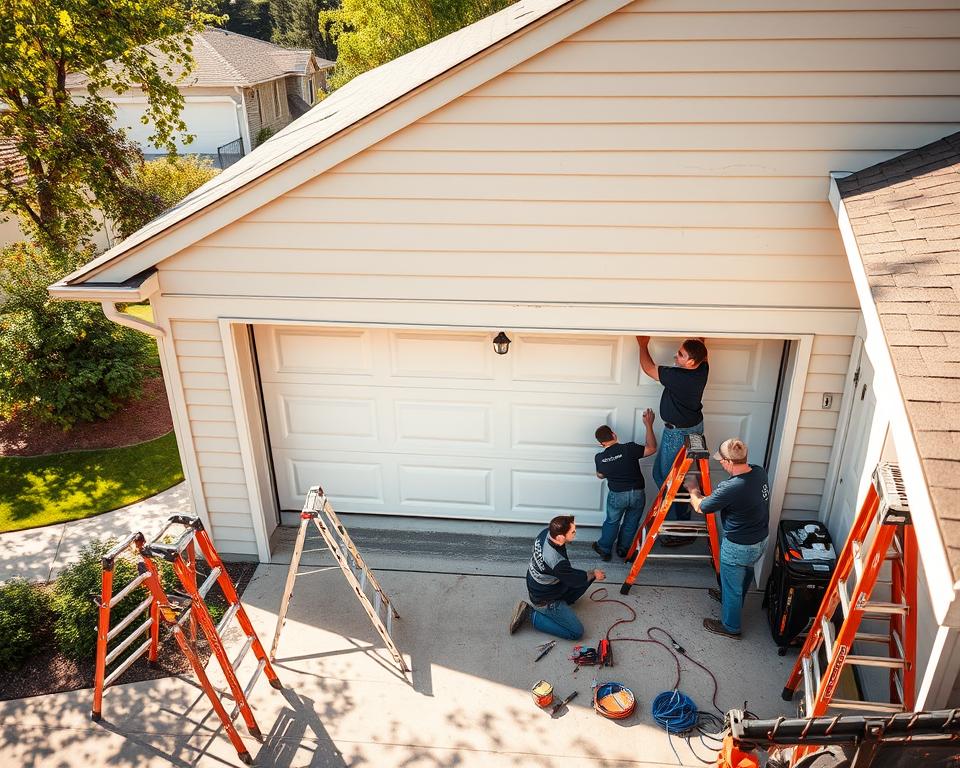Garage Door Setup in Anaheim – Expert Assistance
Have you ever pondered how much your garage door influences your home’s look and safety? Many residents overlook its importance. When exploring door for the garage setup in Anaheim, opting for professional assistance is vital for a flawless mounting. At Coastline Garage Doors, we understand that superior garage door keypad installation enhance both performance and safety, making your home more attractive.
In a competitive market, Coastline Garage Doors stands out with its dedication to superiority. Our team is focused on delivering the finest products and services tailored to your requirements.
Primary Highlights
- Door for the garage setup plays a critical role in enhancing property elegance and protection.
- Professional assistance ensures seamless operation and dependability.
- Coastline Garage Doors provides high-quality products customized to your specifications.
- Selecting the right setup service can help you save effort and resources.
- Expert installations can prevent future problems and upkeep expenses.
Introduction to Door for the Garage Setup
Garage door setup in Anaheim demands meticulous steps for proper function and security. The initial step is selecting the right garage door, considering factors like size, material, and design. A proper fit is essential to avoid problems such as misalignment and operational breakdowns.
Expert setup brings reassurance, ensuring the door operates seamlessly and safely. Experts possess the skills and tools to handle complexities, reducing dangers. It also enhances your property’s charm, improving curb appeal.
Opting for the right professionals in Anaheim ensures a effortless setup and ongoing assistance. This proactive approach saves effort and resources, making professional setup a worthwhile investment.
Why Choose Professional Door for the Garage Setup?
Choosing expert door for the garage setup in Anaheim offers numerous advantages. Experts have the proficiency, tools, and experience needed for a seamless setup. They ensure the job is done correctly, avoiding common challenges.
Professional services adhere to industry norms, which is a major advantage. This means your door for the garage is installed properly, reducing security risks. It also extends the lifespan of your system.
Going with a pro avoids the mistakes often seen in DIY projects. Incorrect dimensions or alignment can lead to costly fixes later. With expert setup in Anaheim, you can rest assured your door is installed correctly and ready to function.
Advantages of New Garage Door Setup
Installing a new door for the garage offers more than just a cosmetic upgrade. Homeowners in Anaheim will find it enhances curb appeal and boosts home security.
Enhancing Curb Appeal
A new garage door can dramatically transform a house’s appearance. It becomes a centerpiece, transforming the property’s exterior. This not only creates a great first impression but also increases the property’s value.
Prospective buyers often favor homes with inviting, modern doors for the garage. For those looking to enhance their home’s appeal in Anaheim, a fashionable, functional door for the garage is a wise investment.
Improving Home Security
Home safety is a major concern for homeowners, and a new garage door significantly enhances it. Modern garage doors come equipped with advanced safety features like rolling code technology and automatic locking. These features make it harder for intruders to enter, giving homeowners in Anaheim peace of mind.
Investing in a new garage door is a smart move for improving home security. It safeguards both your property and your family.

Door for the Garage Setup in Anaheim
Coastline Garage Doors excels in door for the garage setup in Anaheim, catering to each homeowner’s unique needs. Our team is dedicated to delivering top-notch local garage door services, focusing on customer satisfaction and quality. We offer personalized consultations to ensure each project meets our clients’ specific requirements.
Recognizing a door for the garage’s role in your home’s exterior, we guide you in choosing the right style and materials. Our services span a broad spectrum, from classic to modern designs, all installed with meticulous attention. We help clients navigate through options, ensuring their choices enhance both functionality and beauty.
Reliability is essential in garage door setup in Anaheim. Coastline Garage Doors is known for its reliability and expertise in the community. Our skilled technicians bring years of experience to every project, guaranteeing efficient, durable, and secure installations. Our commitment to quality craftsmanship ensures your door for the garage will last for many years.
For outstanding door for the garage setup in Anaheim, turn to Coastline Garage Doors. We encourage the community to contact us and experience our exceptional service and support in local door for the garage services.
Types of Garage Doors Available
Homeowners looking to upgrade or install a new garage door have numerous options available. Understanding the different types of garage doors can significantly influence your decision. It can also enhance your home’s functionality and appearance. Among the popular choices are overhead doors for the garage and custom garage doors, each serving unique purposes while catering to specific design preferences.
Overhead Doors for the Garage
Overhead doors for the garage are one of the most common types found in residential properties. These doors open by rolling up along tracks mounted on the ceiling. Their space-saving design allows for easy access and maximizes usable space within the garage. Many homeowners in Anaheim prefer overhead doors for the garage due to their straightforward operation, durability, and wide range of styles and materials available. This makes them suitable for various architectural styles.
Custom Garage Doors
For those seeking a distinctive look, custom garage doors are an excellent choice. These doors can be tailored to fit specific size requirements, styles, and finishes. This allows homeowners to express their personal taste and enhance curb appeal. In Anaheim, custom doors for the garage are gaining popularity as they can be designed to match or complement existing home features. This provides a cohesive aesthetic that stands out in the neighborhood. Choosing a custom solution ensures that you receive a door that meets both functional and visual demands.
Garage Door Openers: A Key Component
Door for the garage openers are essential for the smooth operation of your door for the garage. Knowing the different types available in Anaheim can boost convenience and safety. Choosing the right opener enhances functionality and can save on maintenance and energy costs over time.
Types of Door for the Garage Openers
There are several types of garage door openers, each with unique features and advantages:
- Chain Drive: Known for their durability and cost-effectiveness, chain drive openers use a metal chain for operation. They are most suitable for heavy doors and are excellent for long-term use.
- Belt Drive: These openers utilize a rubber belt, providing a quieter operation compared to chain drives. Ideal for homes where noise reduction is important, belt drive options often come with advanced features like smart home integration.
- Screw Drive: Functioning through a lifting mechanism that moves along a steel rod, screw drive openers require less maintenance. They perform well in various weather conditions and are suitable for medium-weight doors for the garage.
Significance of Choosing the Right Opener
Selecting the right opener is essential for the optimal function and safety of your garage door. A well-suited opener will boost productivity, minimize breakdowns, and lengthen the duration of your garage door system. When choosing a garage door opener, think about door mass, sound preferences, and additional features like remote access. Comprehending the types of garage door openers at your disposal in Anaheim is essential to making an knowledgeable choice.
Garage Substitution Assistance
Boosting your home often calls for a garage door exchange in Anaheim. Homeowners may find their old doors lack security or aesthetic. This is typical when repairs become recurring and the door shows indications of wearing out.
Coastline Garage Doors shines in replacing old garage doors with precision. This service boosts your home’s appearance and operation. With high-quality materials and skilled installation, your new door will last, supplying trustworthy assistance for decades.
Upgrading your garage door can also enhance power efficiency and lower noise. A new design can make your home more attractive, placing it apart in the community. Homeowners in Anaheim should weigh these advantages when thinking about a garage door substitution.
For educated selections, arrange a appointment with specialists. They can appraise your current door and propose the best substitutes. Trust the method for a undertaking that meets your needs and tastes.
Garage Repair and Care
Routine upkeep of your garage door in Anaheim is vital to prevent usual issues that require fixes. Knowing what can go wrong assists you detect the evidence of necessary fixes. By adhering to routine care, you can extend your garage door’s life and stop costly mendings.
Usual Troubles Calling for Repairs
Various troubles can cause the need for garage door fix in Anaheim. Malfunctioning openers are typical, often due to electrical problems or frayed components. Damaged springs, which support the door’s weight, can fail totally if damaged. Misalignment also impacts the door’s performance, making it important to watch how it functions.
Routine Upkeep Advice
Embracing routine maintenance habits is vital for your garage door’s longevity. Start with routine examinations to spot any damage and damage. Greasing components like cylinders and joints ensures uninterrupted performance and avoids damage. Dealing with small issues quickly can prevent more major and costly mendings. These maintenance advice for your garage door in Anaheim will keep your configuration productive and trustworthy.
Installing Garage Door Insulating Material
Appropriate garage door insulating material in Anaheim offers several merits for property owners. It improves both power effectiveness and comfort. One essential advantage is the substantial reduction in power statements. Insulating a garage door minimizes heat transfer, maintaining the space snugger in cold weather and colder in summer.
This thermal constancy helps in a pleasant atmosphere. It also helps in reducing power usage. Residents can enjoy a more cozy garage space, which is vital if it’s used as a studio or warehousing area.
Sound diminishment is another convincing cause for spending on garage door insulating material. Sufficient insulating material soaks up noise, minimizing noise from outdoor traffic, garden tools, and other disturbances. Homeowners can experience a more tranquil garage area, which is beneficial for any garage application.
The benefits of insulating material extend comfort. Thermal insulating garage doors can stop freezing conditions. These conditions can damage vehicles and machinery stored within the garage. Coastline Garage Doors provides personalized responses for different garage door types. This guarantees every property owner can find the right fit for their demands. With specialist installation services, comprehending the crucial role and benefits of insulating material becomes easy and available.
Expert Garage Door Mounting Procedure
The journey of mounting a garage door starts with a detailed appointment. This initial meeting is where experts get to understand what you need and want. It’s also when they take accurate measurements to secure the door suits perfectly.
After taking measurements, you’ll pick from a variety of garage doors that match your aesthetic and requirements. Once you’ve made your decision, a thorough strategy is created. This strategy details the methods for the installation, focusing on high-quality substances and the right techniques.
During the installation, proficient professionals abide by a exact approach. They make sure every element is in place and securely fixed. This careful focus secures the door works well and lasts for years. A properly mounted garage door not only functions effectively but also improves your home’s protection and appearance.
What Makes Choose Coastline Garage Doors?
Choosing the right support for your garage door needs is vital for both operation and style. Coastline Garage Doors stands out by providing high-quality quality and trustworthy service. They cater to local consumer needs with customized answers.
Coastline Garage Doors exhibits a wide variety of products, securing you discover something that matches your aesthetic and economic plan. Their crew of expert professionals is prepared in mounting and the most recent garage door technologies. This means you can rest secure that your installation is in competent hands.
Client satisfaction is at the heart of Coastline’s objective. They strive to go beyond anticipations with personalized help. Regardless of it’s a new installation or upkeep, their devotion to superiority is unwavering. This dedication makes Coastline Garage Doors a pacesetter in the industry.
| Characteristic | Coastline Garage Doors | Competitor A | Rival B |
|---|---|---|---|
| Range of Items | Wide variety consisting of personalized options | Limited varieties available | Basic alternatives solely |
| Technician Proficiency | Highly educated experts | Elementary training | Diverse skill degrees |
| Customer Contentment Warranty | Positive, strong focus on support | Regular warranty | Zero assurance offered |
| Reaction Time | Rapid and effective | Slower reply | Fluctuates greatly |
Conclusion
Selecting garage door mounting in Anaheim can significantly enhance your home’s operation and appearance. Skilled mounting secures a flawless alignment and dependable performance. It also boosts security and energy effectiveness. Quality assistance can turn your garage into a more efficient and eye-catching room, meeting your particular requirements.
This article has shown the several merits of a new garage door, from boosting street charm to adding advanced safety characteristics. Businesses like Coastline Garage Doors in Anaheim play a essential function in choosing the right door and activator for your home. They ensure a optimal blend of aesthetic and performance.
When looking into your options, reach out to Coastline Garage Doors for personalized solutions. Their commitment to superiority and customer satisfaction will help you along the installation method. They promise achievements that will persist for decades.









